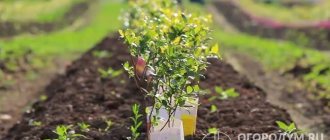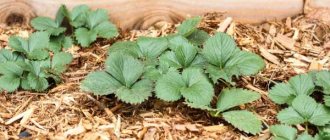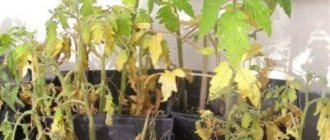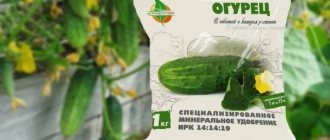Why do tomato seedlings need feeding?
Fertilizing is extremely important at the stage of growing seedlings - the strength of the plants and their subsequent development depend on the fertility of the soil.
Tomato seedlings need feeding for:
- high immunity to diseases;
- ability to tolerate transplantation well;
- ability to withstand external factors after transplantation to a permanent place - in open ground or under film cover;
- obtaining large and tasty fruits;
- for high productivity.
Gardeners often make the mistake of concentrating on watering and disinfecting the soil, and do not feed the seedlings on time. Seedlings need to constantly replenish the energy spent on growth. Moreover, every day the “appetites” of the growing young animals are growing.
The best time to feed tomatoes
Tomatoes are fertilized from the moment the seedlings are planted in pots or boxes. Apply the first feeding to the second or third true leaf. Apply the next two portions of fertilizer every 10 days, and the last one a week before planting in open ground.
The first fertilizing on the site is carried out 2-3 weeks after planting the seedlings. At this time, they begin the phase of active growth, so fertilizers are needed for juicy large fruits.
Photo: 2sotki.ru
How and what to feed pepper seedlings correctly
How to determine what substances tomato seedlings need?
To grow, seedlings definitely need nitrogen, phosphorus and potassium. In smaller quantities - other microelements.
The main fertilizers for tomato seedlings and their effect:
| Fertilizer | Effect |
| Nitrogen | Wide and strong foliage |
| Phosphorus | Active flowering and high immunity |
| Potassium | Enhanced root development |
Vegetable growers can determine from one type of plant what elements it lacks.
Signs of nutritional deficiencies and how to eliminate them:
- Nitrogen. Excessive elongation of seedlings, especially aggravated by insufficient lighting. Leaves turning pale. Nitrogen deficiency is eliminated by adding urea or nitroammophosphate. Subsequently, in open ground, the deficit can be compensated by adding mullein, bird droppings and green fertilizers.
- Potassium. Curly hair on the top of the head is a clear sign of potassium starvation. The shortage is compensated for by adding potassium sulfate or wood ash.
- Phosphorus. The leaves are curled and have a purple tint. Shedding of flowers and ovaries. Add wood ash and superphosphate.
- Iron. Yellowing of leaves, veins remain green. Iron deficiency causes a condition called chlorosis. Add iron preparations to the soil – “Aquamix”, etc.
- Calcium. The leaves are deformed and have yellow spots on the green background. You can make up for the deficiency with wood ash, eggshells, and bird droppings.
- Magnesium. Brown spots appear on the leaves, and the stems become brittle. Wood ash, slurry, and magnesium help correct the situation.
- Manganese and copper. Plants often get sick and grow slowly. Special copper-containing preparations and potassium permanganate are added.
Why fertilize plants?
At each stage of development, tomatoes need feeding with useful elements.
They begin to introduce them with the appearance of the third true leaf. The very first fertilizing is carried out after planting in the ground. If you want to learn more about all the stages of fertilizing tomatoes, read the material at the link.
The main nutritional components for this vegetable crop are nitrogen, potassium, phosphorus, iron, magnesium.
When there is a deficiency of one or another substance, the plant develops various abnormalities in growth and development. Eg:
- A lack of phosphorus causes slow growth, the leaves acquire a reddish-purple hue, and the edges of the leaf blade curl. This substance is necessary for the formation of the root system and improving the taste of the fruit.
- With a severe lack of nitrogen, you can see sluggish, light green, lifeless leaves, a thin stem, and underdeveloped roots.
- Potassium deficiency is diagnosed when blossom end rot is detected. Thanks to this component, tomatoes gain resistance to various infectious pathogens and temperature changes.
- Pale leaves with obvious green veins indicate iron deficiency and developing chlorosis.
- The uneven green color of tomato leaves, the so-called marble effect, is due to a lack of magnesium .
Proper and timely feeding will help correct this difficult situation.
Important. Excess nitrogen fertilizers lead to the growth of green mass in tomatoes to the detriment of flowering and fruits.
If the plants grow rapidly, but the flowers do not set, most likely you overfed them.
Rules for feeding tomato seedlings
In a limited amount of land, it is impossible to collect the full supply of macro- and microelements necessary for the growth of tomato seedlings. Therefore, fertilizing has to be done regularly - as the seedlings grow.
Rules for feeding tomato seedlings:
- The water from which nutrient solutions are prepared must be warm and settled.
- Water over moist soil to avoid burning the roots.
- Foliar feeding - spraying, is carried out in the absence of direct sunlight, so as not to provoke leaf burns.
- It is better to apply fertilizers in the morning. Evening feeding often causes fungal diseases.
- To ensure that fertilizers are as effective as possible, tomatoes are sown for seedlings in loose soil. If necessary, it can be carefully loosened.
When feeding tomato seedlings, it is necessary to take into account the features of applying various types of fertilizers:
- Liquid. Delivers nutrients well. Liquid fertilizer is diluted in a certain amount of water. The resulting solution is used to water the soil or spray the seedlings.
- Dry. First, it is dissolved in water and then applied to the soil. If you scatter dry granules over seedling boxes, the fertilizer will not be absorbed by the plants. In dry form, granules are applied only in greenhouses and open ground.
When choosing between organic and mineral fertilizers, they take into account the condition of the seedlings - their appearance, size, need for a specific element.
How and when to sow seeds for growing tomato seedlings
A week before sowing, bring the prepared home-grown nutrient mixture into a warm room to warm it up and place it in a suitable container for seedlings, water it generously with a 1% solution of potassium permanganate. Immediately draw the soil surface compacted by this irrigation into rows with an interval of 3 centimeters and sow seeds in them as rarely as possible. After sowing, carefully pour a 2-centimeter layer of soil on top in small doses and water with irrigation. Cover the box with film and leave it until the seedlings germinate at room temperature 20-26 warm degrees.
Temperature regime for keeping tomato seedlings:
- The first week after germination - indoors: +15-16 C day / night +10 +12 C;
- Second week - increases during the day: +22-24 C / at night +12 +15 C.
In order for seedlings to develop strong and stunted, it is necessary to extend daylight hours with the help of lighting to 14 hours or more. Don’t forget about picking tomato seedlings! During the first picking, seedlings that have reached the third true leaf are planted in separate cups, 1/3 filled with the nutrient mixture, burying the plants up to the cotyledon leaves. Further, this will allow you to select more powerful plants with a strong root system.
Feeding tomato seedlings at home
Feeding seedlings cannot be carried out haphazardly. Fertilizers are applied at a certain time using a special composition.
First feeding after germination
The first feeding is carried out at the stage of formation of the second true leaf. Preference is given to weak nitrogen-containing compounds.
The nutrition of the sprout begins from the moment the first root appears - it is time to apply fertilizer. But you cannot feed seedlings at the cotyledon leaf stage; the seedlings are still very weak and feeding will most likely cause damage.
If a substrate was used instead of soil, then the first fertilizing is carried out after picking. The purchased mixture contains a complete “set” of nutrients, and the application of fertilizers can be postponed.
If the soil mixture is homemade, then fertilizers are applied approximately 2 weeks after emergence. The first fertilizing should fill the soil with three main elements - nitrogen, phosphorus, potassium.
For feeding you can use the following composition:
- potassium sulfate – 1/2 tsp;
- urea – 10 granules;
- superphosphate – 1.5 tsp;
- water – 3 l.
This option would also work:
- superphosphate – 1 tbsp. l.;
- ammonium nitrate – 1 tsp;
- potassium sulfate – 1 tbsp. l.;
- water – 5 l.
For the first feeding, you can use complex fertilizers, for example, Agromax, Agricola and similar compounds.
Thanks to the first feeding, tomato seedlings take root well and survive safely after picking.
An interval of 4-5 days is maintained between fertilizing and picking.
Second feeding after picking
The second feeding (for seedlings grown in the substrate - the first) is carried out 10-14 days after picking. At this stage, complex fertilizers containing a small dose of fungicides are applied.
Recommended fertilizers:
- Nitrophoska – 15 g per 1 liter of water;
- Agricola – 25 g per 10 liters of water;
- Strong – 10 g per 10 l;
- Sodium humate – 250 ml per 5 l;
- Effecton – 1 tbsp. l per 1 l.
You can prepare the composition yourself from:
- calcium nitrate – 2 tsp;
- sifted ash – 1/2 cup;
- water – 5 l.
If the seedlings are stretched excessively, you need to quickly add superphosphate. The solution is prepared by mixing 3 tbsp. l. substances with 3 liters of warm water.
Third feeding before planting in the ground
The third feeding is carried out 2 weeks before transplanting into open ground, if the need arises.
Fertilizers for the third feeding:
- Nitrophoska – 1 tbsp. l. for 10 l;
- A mixture of double superphosphate - 4 g, potassium salts - 8 g, urea - 1 g is diluted in 1 liter of water.
During the third feeding, a lack of elements is diagnosed by appearance. If necessary, add the appropriate element.
The third feeding is often carried out not at the root, but by spraying on the leaf. If the deficiency of elements is small, chemical preparations are replaced with natural ones.
Fourth feeding after planting in the ground
This is the last feeding of the seedlings, it can be the third in a row if the seedlings did not have to be fed before due to a lack of elements.
Recommended fertilizers per 5 liters of water:
- superphosphate – 1 tbsp. l.;
- potassium sulfate – 1 tbsp. l.;
- ammonium nitrate - 1 tbsp. l.
The resulting mixture is watered at the roots of the seedlings. Or they use a complex fertilizer, for example Kemira.
Seedling problems, what to feed
The future harvest directly depends on the quality of seedlings. Therefore, it is important that the plants are initially healthy and strong. Before planting in open ground, seedlings should be assessed so that their condition can be corrected if various problems arise.
If she is thin, pale
When seedlings look frail and weak, some gardeners are afraid to plant them, believing that they will not make good bushes. But that's not true. The situation can be corrected by reducing watering, increasing lighting and lowering the temperature. Also, the pale color of the leaves can be caused by either an excess of nitrogen or a lack of it. The Atlet preparation will help make seedlings stronger and prevent stretching. Excess nitrogen is neutralized by adding superphosphate.
If, according to your assumptions, the seedlings do not have enough nitrogen, apply nitrogen fertilizer, for example, a solution consisting of 1 tbsp. l. urea and 10 liters of water. 100 ml of this fertilizer is poured under each bush and the seedlings are kept at a temperature no higher than 10°C for the next two days without watering.
As soon as growth stops and the leaves acquire a rich color, the seedlings are transferred to their usual conditions, providing them with warmth and regular watering.
If tomatoes grow poorly
It happens that seedlings begin to grow poorly after picking. The reason may be improper planting, during which the roots were damaged or bent. If the picking was done according to all the rules, but the leaves still turn yellow and there is no growth, it means that the soil was not selected well.
- Poor seedlings may be due to a lack of potassium - in this case, the leaves turn yellow and curl.
- Uneven leaf color indicates magnesium deficiency.
- Signs of a lack of iron, nitrogen and phosphorus in the soil were written above.
Use complex mineral fertilizer with a large range of microelements to feed tomatoes. This will help solve the problem of insufficient seedling growth.
Mineral fertilizers for tomato seedlings
These fertilizers are highly effective and bring great benefits to tomato seedlings. But the correct dosages must be observed.
Nitrophoska
Nitrophoska is recommended for weak seedlings. Nitrophoska is added approximately 5-7 days after picking, in the form of a solution. For 1 liter of water take 15 g of nitrophoska. This volume is enough for about 50 seedlings.
Next time, the seedlings are fed with nitrophoska during transplantation into the ground. It is important to mix the granules with moist soil so as not to burn the roots.
Agricola
The drug contains phosphorus (20%), nitrogen (15%) and potassium (25%). The preparation contains iron, boron, magnesium, and manganese in small quantities. The purpose of "Agricola" is to strengthen seedlings, activate their growth and development.
2.5 g of fertilizer is diluted in 1 liter of water. Water the seedlings at the roots. Not suitable for foliar spraying. Agricola can be used only 2 weeks after the pick.
Effecton
Belongs to the group of organic fertilizers and effectively stimulates the growth of seedlings. Fertilizer is obtained by composting peat and adding wood ash or dolomite flour, potassium chloride, and phosphate rock to it. The composition of "Effecton" is similar to manure.
To obtain a solution, dilute 3 tbsp in 10 liters of water. l. facilities. The composition is applied at the root or used to spray seedlings.
If Effekton is used to feed seedlings, then no other fertilizers are used.
Athlete
The drug regulates growth. It slows down the growth of seedlings, making them stronger by stimulating root growth:
- While using Athlete, watering is stopped. After 1-2 days, the soil is sprayed with a spray bottle for better effect.
- If the seedlings are stretched, “Athlet” is applied 4 times with an interval of 5 days. Treatment is stopped a week before planting seedlings in the ground.
- Start using the drug after the formation of three true leaves.
Urea
Replenishing nitrogen deficiency leads to an increase in green mass and strengthening of stems. When fertilizing seedlings, it is applied in liquid form. It is recommended to water before adding to the soil. 20-30 g of urea are dissolved in 10 liters of water. The concentrated solution should not get on the leaves - it can cause burns.
Foliar feeding is possible - they are more effective than applying at the root. Spray a solution prepared at the rate of 15 g per 3 liters of water. Spray the plants in the early morning or evening.
To accelerate the growth of seedlings, before sowing, add 2 g of urea to each box.
At what time should you fertilize?
Of course, if a plant shows a lack of a certain element, then it is necessary to apply appropriate fertilizing. If there is a lack of nitrogen, urea should be used, if there is a lack of phosphorus - superphosphate, and if there is a lack of potassium - potassium nitrate.
Tomatoes begin to be fed already at the time of receiving seedlings. After planting it in the ground, they usually do 3 feedings - after planting, when the bushes are blooming and during the fruiting period. In general, the number of procedures depends on the condition of the soil - on poor soils you can feed every two weeks.
It is best to feed the beds in the morning or evening. When applying fertilizing to open beds, weather conditions are taken into account.
Organic fertilizers
All organic fertilizers are environmentally friendly and effective. The main thing in their use is timeliness and correct dosage. They are added at the initial stage of growing seedlings, as they contain a lot of nitrogen - it stimulates the growth of green mass.
Compost
Used at the beginning of the growing season to enhance the growth of the aboveground part. Prepared from manure or plants. Infusions are diluted in water 1:10. If the fertilizer is based on bird droppings, it is diluted in a ratio of 1:15.
Vermicompost
This is industrial organic matter. In Biohumus, the seed is kept and the seedlings are fertilized for active growth. The solution is prepared by mixing the drug and water 1:20. Water to the roots.
Mullein
Mullein stimulates the growth of seedlings and promotes their strength. A fermented composition is used. Pour 10 kg of mullein into a bucket of water. Insist for a day in a warm place. Mullein is applied for the first time 2 weeks after planting the plants in the ground.
Folk remedies for tomato growth
A rich harvest of tomatoes is the desire of every gardener. Therefore, there have always been feedings that had a positive effect on the growth of tomato bushes and the formation of fruits. Below we will present substances that have been repeatedly tested in practice and guarantee excellent results.
Feeding with iodine
This substance stimulates the ovary and active growth of tomatoes. Experienced summer residents say that after iodine, the fruits become even tastier. To prepare a solution for feeding, you need to dilute 3 ml of regular iodine in a bucket of warm water. It is drawn from the bottle with a regular injection syringe. The substance is thoroughly stirred. The maximum dosage of the finished solution is ½ liter per bush. Such fertilizer will also be an effective protection against late blight.
Feeding with ash
This is a natural fertilizer with complex action. Thanks to its high content of sodium, magnesium, potassium and calcium, it provides tomatoes with nutrients at all stages of growth and development. Crushed ash is poured into holes when planting seedlings in the garden, and they are also simply sprinkled with dry matter on the surface of the soil. But it is best to prepare an ash solution. A glass of raw materials is stirred in a bucket of water. There is always sediment left at the bottom, which is also used. This is how fertilizer is prepared for the growth of tomato roots.
To process tomatoes leaf by leaf, take 300 g of ash per three-liter container of water and boil for half an hour. The ash will infuse for 5 hours. After this, you need to add water so that the total volume of the tincture reaches 10 liters. You can rub a little laundry soap on top. Then the liquid is filtered through several layers of gauze and the tomato bushes are sprayed with it.
Yeast feeding
Dry materials dissolve the fastest. To feed tomatoes, you need to take warm water, pour one packet of yeast into it and add another 6 tsp. granulated sugar. The mixture is continuously stirred until all ingredients are completely dissolved. The yeast solution is poured into a bucket of water. For growth per bush you need to use 2.5 cups of fertilizer.
In a bowl with high sides, knead rye bread and cover 2/3 of the volume with a cold solution of fresh yeast (100 g of packaging is enough). The container is kept in a warm place for 4 days. After this, the liquid is filtered and further diluted with water in a ratio of 1:10. For the growth of tomatoes, 0.5 liters of fertilizer are poured under young bushes, and a fifth of a bucket is poured under flowering bushes.
Important! Yeast itself does not contain the necessary microelements for tomato growth. Additional components must be added to them. All solutions prepared on their basis are natural growth stimulants.
Feeding with chicken manure
Bird feces contain a lot of phosphorus and nitrogen. Pure manure is never used to feed tomatoes. Due to the high concentration, severe burns form on the roots. One part of litter requires at least 3 parts of water. The liquid should infuse for a week. 1 liter of infusion + 20 liters of water, and the fertilizer is ready. It is used for watering row spacing (5 l/m2 of land).
Feeding with mullein
Its composition largely depends on the diet of animals. Mullein contains the least phosphorus, but it will become a complete source of nitrogen and potassium. Preparing fertilizer for tomato growth is quite simple. Place 1 part of manure in a spacious barrel or other container and pour 5 parts of water on top. Mix everything well and seal the container with a lid.
It will take about 14 days for the mullein to brew. Every few days the contents should be checked and stirred again. If bubbles appeared, the manure began to actively ferment. Over the course of a week, the mixture will become lighter in color and the solids will form a sediment. Before feeding tomatoes, mullein is diluted by half again. To enhance nutritional value, approximately 0.5 kg of wood ash and 100 g of superphosphate can be added per 10 liters of fertilizer.
Important! Around each bush you need to make small grooves for watering. When the liquid is absorbed, they are sprinkled with earth.
Fertilizing with nettles
Feeding for tomato growth is also done on the basis of young grass. You can add dandelions, alfalfa or any other weeds to nettles. You need to prepare a large plastic container in advance and fill it 2/3 with stems and leaves. Pour water on top, leaving some space. This will promote better fermentation. For the next week and a half, the nettle will be infused under a tight lid.
A liter jar of fertilizer is poured into a bucket of water and mixed thoroughly, now you can start feeding. From 1.5 to 2 liters of nettle liquid is poured under one tomato bush. It contains a lot of nutrients, so it is unreasonable to abuse this fertilizer.
Natural remedies
The advantage of natural remedies is safety. Most fertilizers are prepared from available materials that can be found in every household.
Hydrogen peroxide
To stimulate growth, seedlings are watered with a solution of hydrogen peroxide. It is obtained by mixing 1 tbsp. l. drug with 1 liter of warm water. The resulting solution is used as foliar feeding.
The prepared solution can be applied at the root to combat root rot, but after its use small roots die.
The frequency of spraying is determined individually. Spruce seedlings are in good condition - the leaves are large, and the stems are strong and thick; it is enough to apply a peroxide solution once every 10 days.
A solution of hydrogen peroxide is an effective disinfectant; it is used to treat the soil poured into seedling boxes.
Ash
Wood ash is one of the most popular fertilizers among gardeners. It contains many microelements, is a powerful preventive agent, and has a protective effect.
Before use, the ash is diluted in water. The aqueous solution is applied to the root in pure form, or mixed with herbal infusion.
Ash is also used in dry form. Moreover, it acts not only as a fertilizer, but also repels pests, and most importantly, prevents blackleg - the most dangerous disease for seedlings.
Boric acid
Boric acid contains boron. This microelement is necessary for seedlings to grow normally; it:
- enhances metabolism;
- activates the growth of roots and green mass;
- increases the amount of chlorophyll.
Prepare the fertilizer by diluting 1 g of the product in a glass of hot water. Next, the glass with the solution is diluted in 1 liter of water. Mix thoroughly and water the resulting solution at the root of the seedlings.
A solution of boric acid can be used for foliar feeding. The leaves of the seedlings actively absorb the necessary microelements.
Yeast
This affordable product is a source of microelements necessary for the rapid growth of strong tomato seedlings. Seedlings with such fertilizing will grow by leaps and bounds.
Preparation of yeast dressing:
- 10 g of dry yeast are dissolved in 1 liter of water.
- Add 1 tbsp. l. Sahara.
- When the solution rises, dissolve it in one bucket of water.
Water at the root. The solution must be used within 24 hours.
Other recipes for yeast feeding for seedlings are given here.
Iodine
Iodine supplements have a multifaceted effect, they:
- stimulate the growth of green mass;
- have a beneficial effect on the process of fruit ripening and improve their quality;
- have a bactericidal effect;
- increase the immunity of seedlings;
- increase the yield of tomatoes.
The fertilizer is prepared by dissolving 10 drops of iodine in 10 liters of water. The solution is applied at the root.
Egg shells
Eggshells are useful for thin seedlings. It is rich in calcium carbonate, phosphorus, silicon, magnesium, potassium. Plants gain strength, become stronger, “stockier”. The shells are first kept in water for 3 days.
Onion peel
Onion peels contain many nutrients; they contain carotene, phytoncides, vitamins B and PP. Husk infusion can replace water with each watering or from time to time.
How to prepare the solution:
- Take a couple of handfuls of onion peels and pour 1 liter of hot water.
- Let it sit for 24 hours.
Water the seedlings at the root with an undiluted solution.
Milk
Milk contains potassium, copper, calcium, iron, phosphorus and other trace elements. Improves photosynthesis, increases the effect of organic fertilizers.
A nutritious and disinfecting mixture is prepared from milk by mixing the following components:
- milk – 1 glass;
- iodine – 5 drops;
- water – 1 l.
Potassium permanganate
Potassium permanganate solution is a source of manganese and potassium. The solution is usually applied as foliar feeding. Potassium permanganate is often mixed with manure or wood ash. It is not only a top dressing, but also an antiseptic.
Seedlings are fed with potassium permanganate twice. The solution is prepared by mixing 10 liters of water with 5 g of powder. The frequency of application is once every 10 days.
Coffee grounds
It nourishes and strengthens seedlings, and also makes the substrate looser - this promotes root development. The grounds are simply added to the soil, and to prevent the soil from acidifying, ash is added at the same time.
Nettle infusion
To prepare the fertilizer, take fresh, just cut nettles. The tops are chopped and filled with water - 2:1. Cover the container with the infusion with a lid and place in a warm place.
After 7-10 days of infusion, the fermented nettle infusion is diluted with water (1:10). Plants are watered with this solution at the root.
Feeding tomatoes with yeast
Frequent nitrogen fertilizing results in fattening of bushes
Let us clarify that it is better to feed tomatoes with yeast after planting them in a permanent place in a greenhouse or open ground.
Such fertilizing is carried out only 2 times per season, otherwise there will be solid greenery, to the detriment of fruit formation. Tomatoes are fed with yeast in June, when the plant needs to gain strength and develop thick stems and good roots.
To prepare the working solution, you need to take 1 kg of baker's yeast in a briquette, dilute it in 5 liters of warm water and let it brew for a day. To feed tomatoes, 0.5 liters of this solution is added to a bucket of water and watered under the bushes. Half a liter of solution is consumed per plant. This is simply feeding with yeast. Many gardeners add infusions of herbs and chicken manure to this fertilizer to enrich its composition. Any fertilizing is applied to moist soil, so tomatoes must be watered first.
The results of this feeding will be visible within a week. The saying “grows by leaps and bounds” is confirmed in practice.
Another recipe for yeast feeding: put 100 g of live yeast and half a glass of sugar in a 3-liter jar. Fill with warm water almost to the top and place in a warm place to ferment. Before the end of fermentation, the jar sometimes needs to be shaken. Use the resulting “mash” to feed tomatoes at the rate of 1 glass per 10 liters of water. Feed with this fertilizer once at the rate of 1 liter per bush.
Useful tips
Experienced vegetable growers advise:
- Excess nutrition can cause an increase in green mass and elongation of the stem. In this case, the seedlings must be moved to a place with lower temperature and lighting.
- Banana peels can be used as a top dressing - this is a good source of potassium. The infusion is made by pouring 3 liters of water over the peels of three bananas. After three days, the infusion is ready - you can water the seedlings.
- Fertilizing will be much more effective if you regularly loosen the soil near the plants.
Growing tomato seedlings requires maximum attention from the gardener; it is important not only to fertilize on time, but also to correctly “make a diagnosis.” The future harvest depends on the timeliness of fertilizing, the correct choice and dosage.
When seedlings need feeding
Healthy tomato seedlings need two feedings:
- the first is done 7-10 days after picking the tomatoes;
- a week later they carry out the second one.
Before this, if the seeds were planted in purchased soil, the tomatoes did not need fertilizer. Additional fertilizing with a complete mineral complex or some individual element is carried out when the crop shows signs of starvation or is lagging behind in development.
The agronorm of tomatoes is N+P+K=58, proportions are 36:19:45. Botanists and experienced gardeners, just looking at these numbers, will say that the crop needs nutrition with high doses of phosphorus, moderate doses of potassium, and a very small amount of nitrogen. But this is for adult tomatoes.
Young people primarily need nitrates. They are the building material for plant tissues. Again, in reasonable quantities. If nitrogen is not dosed, the seedlings will stretch out, lie on the ground, and become infected with blackleg.
Before feeding tomatoes, you need to know what nutrients they need:
- nitrogen is responsible for the growth of green mass and participates in photosynthesis;
- phosphorus is the most important macronutrient for tomatoes, it is needed for flowering and fruiting, prevents the ovaries from falling off;
- the main task of potassium is the formation, development, and strengthening of the root system;
- if there is a lack of calcium, nutrients are poorly absorbed, even with excess content in the soil they may not be distributed correctly;
- microelements also play an important role, their deficiency leads to deformation and discoloration of leaves and fruits, various diseases, developmental delays, as a result - a decrease in yield and early death of bushes.
The functions of macro- and microelements are not limited to this. The above description is very simplified, and is intended solely for understanding the importance of a particular component for the life of the plant.
We focus on the stage of development of tomatoes
Any plant, including a tomato, consumes nutrients in different quantities at different stages of development. For example, an actively growing tomato needs an increased amount of nitrogen, and in the budding and fruiting phase, a constant supply of potassium.
Only with accurate knowledge of the needs of a crop during a certain period of development can you create a balanced fertilizer that will not harm the bushes, but, on the contrary, will provide them with the necessary nutrition.
All feeding of tomatoes should be carried out in a strictly defined order.
Randomly introducing one or another substance under the bushes can provoke its excess or deficiency.
As a result of improper fertilizing, tomatoes weaken and are easily affected by pests and diseases, the harvest (if any) loses its varietal characteristics - even the largest-fruited hybrids can produce small, unsightly tomatoes.
Is it necessary to fertilize tomatoes strictly according to schedule?
Since the above scheme for feeding tomatoes is considered general, in specific cases it can vary significantly. For example, if the planting sites for the crop were properly fertilized in advance, then when planting the seedlings, they do not add anything to the soil, but simply spill it. This is also done if the seedlings were fed before planting.
If the tomatoes grow well and are full of health at one or another stage of development, then some points of the diagram can be omitted. If tomatoes lack a certain substance in the soil, they will definitely show it.
Tomatoes grown in separate containers must be fed according to the schedule and, possibly, fertilizers must be added out of sequence. Since the earth in limited quantities quickly becomes poor, it is necessary to constantly replenish its nutritional composition by introducing certain elements.
Many gardeners prefer to use inexpensive and accessible products as fertilizers. For example, ammonia is used in different ways: for fertilizing the soil, treating plants, spraying and watering.











